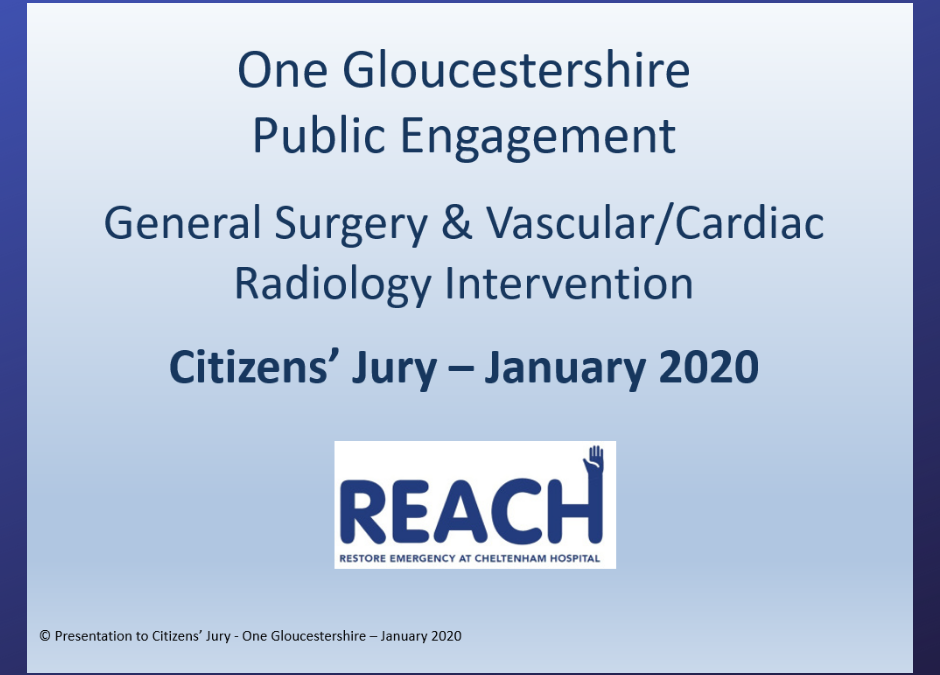The final stage of One Gloucestershire’s Public Engagement ‘Fit for the Future’ was the Citizens’ Jury. That had been scheduled to take place in December, but had to be postponed due to the ‘Purdah’ rules surrounding the General Election.
The Citizens’ Jury spent four days, from Monday 20th to Thursday 23rd January, listening to evidence from NHS Managers and Clinicians about the proposed reconfiguration of services in Gloucestershire, with the final day, Friday 24th January, reserved for their deliberations and to produce a report of their conclusions.
Only two community representatives applied to present to the Citizens’ Jury, one Cheltenham Borough Councillor and REACH. Against nearly four days of evidence from the NHS professionals, they were only given 15 minutes each to present their case!
REACH’s presentation contained 23 slides, but because of the imposed time constraint we chose to only present the 12 key slides. Unfortunately, although one of the Jurors asked if REACH had anything more we wanted to add and we told them there were another 11 slides in our presentation, the Jurors decided not to accept copies of the full set of slides, because they had not been submitted in advance.
The reason REACH had not submitted the slide presentation in advance was a lack of trust and confidence in the public engagement process which is so heavily loaded in favour of the local NHS management. Although the Citizens’ Jury was run by an independent Community Interest Company, they were employed by One Gloucestershire to organise the process.
REACH’s presentation was introduced by Julius Marstrand, a former Public Governor of the Hospital Trust for Cheltenham and Chris Hickey, a former Non-Executive Director of the Primary Care Trust.
Here is the FULL set of slides, both those we included in our presentation and those we left out on the day – One Gloucestershire – Citizens Jury – REACH presentation_21.01.2020
At REACH we are firm believers in making things as easy to understand as possible so below is an explanation of the slides.
Slide 1 – Title slide introducing REACH
Slide 2 – REACH’s response to the questions posed to the Citizens’ Jury and the inherent in-balance and apparent bias in the Citizens’ Jury process
Slid 3 – Outlining REACH’s lack of trust and confidence in the Public Engagement process, including the Citizens’ Jury process
Slide 4 – Clearly stating the elements of Fit for the Future REACH does support
Slide 5 – Expressing REACH’s acceptance of the creation of a Centre of Excellence for Emergency Surgery
Slide 6 – The need for an Emergency and Elective/Planned surgery split, to create capacity for Emergency General Surgery to be transferred to Gloucestershire Royal Hospital
Slide 7 – Centralising Emergency Surgery at Gloucestershire Royal Hospital and Elective/Planned Surgery at Cheltenham General Hospital
Slide 8 – REACH’s case for a SYNCHRONOUS separation of Emergency and Elective/Planned Surgery, to create the necessary theatre and bed capacity at Gloucestershire Royal Hospital – something the transfer of six Neurological beds does not provide
Slide 9 – The separation of Emergency and Elective/Planned Surgery is consistent with the ‘Getting It Right First Time’ (GiRFT) strategy
Slide 10 – The need to have resident on-call Doctors – Anaesthetists, Physicians and Surgeons – available 24.7 on both sites
Slide 11 – the risks to inpatients and A&E patients of NOT having resident surgeons in Cheltenham General Hospital
Slide 12 – What the Citizens’ Jury might want to find out about: ‘why was the overwhelming weight of evidence they received so heavily biased in favour of the Hospital Trusts position, when there are equally valid clinical objections to these proposals?
Slide 13 – Any Questions from the Citizens’ Jury
REACH was only allowed 15 minutes to present its case, so it was not possible to present more than the 13 above slides before the Citizens’ Jury had time to ask REACH’s representatives questions. The following slides were included in the hard-copy pack provided for the Citizens’ Jurors, but the Citizens’ Jury were persuaded not to allow these slides to be included in REACH’s evidence to the Jury.
Slide 14 – Summary of the current pressures on Emergency Surgery and possible Options for relieving it
Slide 15 – the current challenges for the Accident & Emergency Department at Gloucestershire Royal Hospital
Slide 16 – A Venn diagram of the critical inter-relationships between the two main specialisms of Oncology (Cancer) Treatment and Cardiovascular Treatment at Cheltenham General Hospital and Gastroenterology, Upper and Lower Gastrointestinal Surgery, Gynaecological Cancer and Urology
Slide 17 – Explanation of REACH’s support for a Centre of Elective/planned surgeru at Cheltenham General Hospital
Slide 18 – the inter-relation between Cardiovascular Treatment and Interventional Radiology (IR) Services
Slide 19 – the importance of General Radiological (IR) services at EVERY acute hospital
Slid 20 – Cardiac Internventional procedures, currently part of the Cardiovascular Centre of Excellence in Cheltenham General Hospital
Slide 21 – Acute Cardiac Intervention – so the 24/7 Cardiac facility does not have to be co-located with the major A&E Department at Gloucestershire Royal Hospital, but can continue to be located at Cheltenham General Hospital
Slide 22 – Reasons for maintaining the Centralistion of the Cardiac Unit at Cheltenham General (there have been suggestions if General Surgery is relocated to Gloucestershire Royal Hospital, this might make the relocation of Cardiovascular Care to Gloucester a necessity)
Slide 23 – Vascular Interventional Radiology (IR) Centre the reasons for maintaining this at Cheltenham General Hospital
Slied 24 – REACH’s view on the need for Cardiac, Vascular and IR Centres on both sites.

